LGBTQ issues exposed
 Workplace safety remains elusive for young LGBTQ Australians, as harassment runs rampant.
Workplace safety remains elusive for young LGBTQ Australians, as harassment runs rampant.
A landmark study has revealed that more than three-quarters of young LGBTQ Australians have faced sexual harassment in the workplace, exposing significant shortcomings in workplace safety and inclusion for this group.
A report commissioned by Australia’s National Research Organisation for Women’s Safety (ANROWS) provides detailed insights into the lived experiences of LGBTQ individuals aged 14 to 30.
Drawing on a survey of 1,001 participants, in-depth interviews with 40 individuals, and a photo-based exercise with eight contributors, the study explored how workplace harassment intersects with systemic issues like homophobia, biphobia, and transphobia.
Many respondents reported that harassment was directly linked to their LGBTQ identities, with incidents ranging from sexually explicit comments to intrusive questions about their personal lives.
These experiences often blurred the boundaries between sexual harassment and broader discriminatory behaviours.
The findings also revealed that individuals presumed female at birth were more likely to encounter offensive remarks about “correcting” their sexual orientation, while non-binary and transgender participants reported frequent and intrusive comments about their anatomy. Many young people reported feeling confusion stemming from societal norms and workplace cultures that fail to provide clear guidance on acceptable behaviour.
A recurring theme in the report was the reluctance of LGBTQ workers to report harassment.
Many opted to leave their jobs instead of pursuing formal complaints, citing fears of retaliation or being forced to come out in potentially unsafe environments.
Participants described a lack of trust in workplace systems, with several recalling instances where colleagues’ reports were inadequately handled or ignored.
For some, the emotional toll of harassment was compounded by feelings of shame, alienation, and internalised stigma, particularly when perpetrators made comments targeting their gender, sexuality, or relationships.
Workplace environments often played a critical role in enabling harassment.
Non-inclusive practices - such as the absence of gender-neutral bathrooms, restrictive uniform policies, and the failure to respect chosen names or pronouns - contributed to cultures where discrimination and harassment could thrive.
Some respondents described being tasked with educating their co-workers about LGBTQ issues, adding emotional labour to their already challenging work lives.
The presence of other openly LGBTQ colleagues, however, was highlighted as a key factor in creating a sense of safety and inclusion.
Another significant concern raised in the study was the inadequacy of workplace training.
Most participants reported receiving little to no meaningful education on sexual harassment, with existing programs criticised as superficial and failing to address the unique challenges faced by LGBTQ employees.
Those who participated in effective training noted it was interactive, facilitated by experts, and inclusive of the nuanced realities of workplace harassment for LGBTQ individuals.
The report called for comprehensive changes to address these issues.
It urges the federal government to launch a national anti-sexual harassment campaign targeting workplaces, schools, and community sectors, while encouraging employers to overhaul policies to better reflect the needs of LGBTQ staff.
In the education sector, the study recommended introducing anti-harassment content into school programs from the primary level onwards, aiming to foster greater inclusivity and awareness from an early age.
Dr Kate Robinson, the lead author, says workplace harassment should be viewed as part of a broader continuum of violence shaped by societal biases.
“Creating inclusive and respectful workplaces is about more than just policy - it is about ensuring that everyone feels safe and supported, free from fear of discrimination or harm,” she said.








 Print
Print